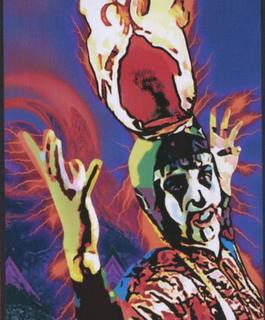
From time to time,
chez nous functions as the Beat Hotel (excellent views and rates; as much olive oil as you can eat) and it has been a great pleasure to have the legendary Arthur Brown, the God of Hellfire in residence over the past month or so.
As chance would have it, he happened to have with him the proofs from the first full-length biography of his life and times, which I have been reading intermittently between dealing with the usual assortment of real-life problems that, inevitably, interrupt any kind of artistic activity.
Written by Polly Marshall, Shirley Collins’ daughter, ‘The God of Hellfire: The Crazy Life and Times of Arthur Brown’ is an eccentric narrative of great charm and interest, which weaves a tapestry of connections, anecdotes, press clips and extensive quotes from Arthur’s own memoirs (drafted in hand on yellow lined paper, as I recall) into a story that almost beggar’s belief.
AB introduced theatricality into rock in a spectacular and formative way in the mid-1960s. He and his two compatriots formed the tallest trio in rock, scaring and stunning their audiences, and became the most heavily booked university band of the time.
Their No 1 single ‘Fire’ remains an iconic memento of British psychedelia. Arthur has told me that he sung the song at Donald Trump’s casino in Atlanta, at a party for Edward Kennedy in early 1969 and was recently helicoptered into a stadium of 40,000 people to sing at the opening of a football game featuring a team named Rhinefire, who have adopted it as their anthem. He says it was ‘much discussed in India and appealed to the Mexicans because of the trumpets.’
Once memorably described as a cross between Screaming Jay Hawkins, Little Richard, Tom Jones and Maria Callas, Arthur Brown has lost none of his extraordinary vocal power and stage presence. I can vouch for this, having seen the man personally mesmerise audiences. Playing guitar and singing in my kitchen, his voice accelerates effortlessly and astonishingly from a primeval and subterranean bass growl to a high register vocal scream that rattled the plates in my kitchen and curls your eyelids. A hard act to follow.
Naturally someone of such great talent has been poorly treated by the music business (it has to be said, not an uncommon thing at that time - or today). He has also been largely sidelined by the music and mainstream press, except as a one-hit wonder.
Yet like many musicians of his originality and calibre, he remains constantly in demand for concerts, collaborations and events in many parts of the world. He runs his own regular nights at the Komedia in Brighton, stages an annual festival in Spain, and produces music and performances of great artistry and style.
Arthur’s importance as a pioneer cannot be underestimated. Witness this marvellous account in the beautiful intro of the book by Howard Marks (‘Mr Nice’ himself) who vividly remembers his first sight of Arthur:
‘Suddenly, a human cannonball wearing Sun God robes and a science fiction mask and with his head on fire arched through the auditorium….Spinning and thrashing his head, he tore off the mask to reveal a face plastered with woad. Everyone jumped up and down and bounced off the walls in frenzied relief. They were dancing to the Crazy World of Arthur Brown, the first psychedelic soul spectacle, a memory that neither experience nor drug could ever erase.’
Then there’s John Peel: ‘I’m ashamed to say it, I don’t remember the Floyd as vividly as I remember Arthur Brown, ‘cos I mean Arthur Brown, at that time, used to stand there and insult the members of the audience in much the same way as people like Johnny Rotten.’
I remember reading how James Brown had taken his whole band, when in Nigeria, to go and see Fela Kuti, who blew him away. Well check this quote from the Godmaster Of Funk and Totally Over The Top Theatrics, Mr George Clinton: ‘We saw Arthur Brown and his Crazy World and the whole thing was just an eye-opener to me. He used to sing ‘I am the God of Hell Fire’ and then he’d set fire to his fuckin’head. That told me a lot. I knew where I was heading from then on.’
According to a heavy metal website (furious.com), the Crazy World are ‘correctly identified as the daddy and granddaddy of all the latter ‘satanic rockers.’ Ozzy covered ‘Fire’ on his 4-CD box set, released earlier this year, as did Prodigy before him. Bruce Dickinson of Iron Maiden is both a friend and huge fan. Check out AB’s ‘Devil’s Grip’ to see where it all came from.
In short, Arthur is a unique figure in British culture who should be celebrated and acknowledged. Spread the word by reading this book, which also contains a rich fund of stories of Arthur’s spiritual travels to Rwanda and Turkey, his legendary painting and decorating business (named Black and Brown) in Austin, Texas, with Jimmy Carl Black from the Mothers, his friendship with Jimi Hendrix and why he stripped naked at the Palermo Pop Festival 70 (and what happened to him in a Sicilian prison as a result).
Arthur Wilton-Brown, born 1942 in Whitby, Yorkshire, to a father who developed the first fully automatic toothbrush — we salute you.
‘The God of Hellfire: The Crazy Life and Times of Arthur Brown’ by Polly Marshall is published shortly by SAF Publishing Ltd (www.safpublishing.com).
[ISBN: 0 9646719 77 2] £20.00.See also:http://www.godofhellfire.co.uk/http://www.arthurbrownmusic.com/




